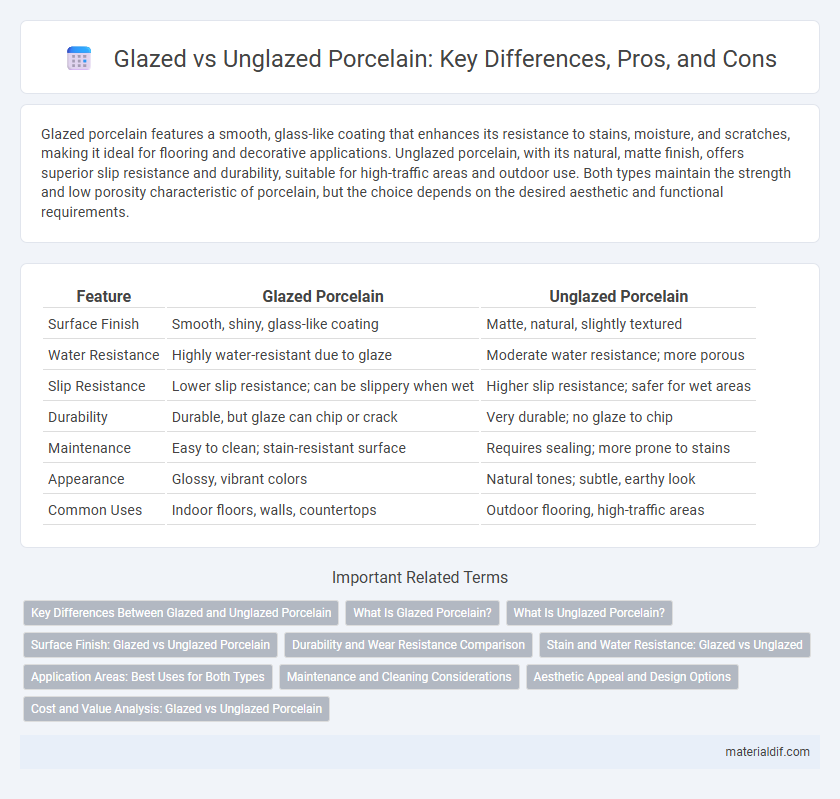Glazed porcelain features a smooth, glass-like coating that enhances its resistance to stains, moisture, and scratches, making it ideal for flooring and decorative applications. Unglazed porcelain, with its natural, matte finish, offers superior slip resistance and durability, suitable for high-traffic areas and outdoor use. Both types maintain the strength and low porosity characteristic of porcelain, but the choice depends on the desired aesthetic and functional requirements.
Table of Comparison
| Feature | Glazed Porcelain | Unglazed Porcelain |
|---|---|---|
| Surface Finish | Smooth, shiny, glass-like coating | Matte, natural, slightly textured |
| Water Resistance | Highly water-resistant due to glaze | Moderate water resistance; more porous |
| Slip Resistance | Lower slip resistance; can be slippery when wet | Higher slip resistance; safer for wet areas |
| Durability | Durable, but glaze can chip or crack | Very durable; no glaze to chip |
| Maintenance | Easy to clean; stain-resistant surface | Requires sealing; more prone to stains |
| Appearance | Glossy, vibrant colors | Natural tones; subtle, earthy look |
| Common Uses | Indoor floors, walls, countertops | Outdoor flooring, high-traffic areas |
Key Differences Between Glazed and Unglazed Porcelain
Glazed porcelain features a smooth, glass-like coating that enhances durability, stain resistance, and water impermeability, making it ideal for bathrooms and kitchens. Unglazed porcelain retains a natural, matte finish with higher slip resistance but requires more maintenance due to its porous surface. The key differences lie in surface texture, maintenance needs, and suitability for specific applications based on aesthetic and functional requirements.
What Is Glazed Porcelain?
Glazed porcelain features a smooth, glass-like coating that enhances its durability, stain resistance, and aesthetic appeal, making it ideal for flooring and wall tiles in high-traffic areas. The glazing process involves applying a liquid glass mixture that fuses to the porcelain surface during firing, creating a waterproof and easy-to-clean finish. This protective layer differentiates glazed porcelain from unglazed porcelain, which lacks this coating and has a more natural, matte texture but is generally more porous and susceptible to staining.
What Is Unglazed Porcelain?
Unglazed porcelain is a type of ceramic material that lacks a glossy, glass-like surface finish, resulting in a matte and porous texture. Its uncoated surface allows for better slip resistance and often requires sealing to protect against stains and moisture absorption. This form of porcelain is commonly used in applications such as flooring and decorative pieces where a natural, less reflective appearance is desired.
Surface Finish: Glazed vs Unglazed Porcelain
Glazed porcelain features a smooth, glass-like surface finish that enhances durability, stain resistance, and ease of cleaning. Unglazed porcelain, with its natural matte or textured finish, offers better slip resistance and a more authentic, earthy aesthetic ideal for both indoor and outdoor applications. The choice between glazed and unglazed porcelain surfaces affects maintenance, appearance, and performance in various environments.
Durability and Wear Resistance Comparison
Glazed porcelain offers enhanced durability and superior wear resistance due to its glass-like coating, which protects against stains, scratches, and moisture penetration. Unglazed porcelain, while highly dense and hard, is more porous and susceptible to surface abrasion, making it less resistant to wear over time. Therefore, for high-traffic areas, glazed porcelain provides a longer-lasting, more resilient surface compared to unglazed varieties.
Stain and Water Resistance: Glazed vs Unglazed
Glazed porcelain offers superior stain and water resistance due to its non-porous glass-like surface that prevents liquids from penetrating, making it ideal for kitchens and bathrooms. Unglazed porcelain, while more porous and susceptible to staining, provides better slip resistance and a natural, matte finish favored in high-traffic or outdoor areas. The enhanced durability of glazed porcelain ensures long-lasting protection against moisture and staining compared to unglazed varieties.
Application Areas: Best Uses for Both Types
Glazed porcelain excels in applications requiring a smooth, non-porous surface, making it ideal for bathroom tiles, kitchen countertops, and decorative surfaces that need stain resistance and easy cleaning. Unglazed porcelain is preferred in high-traffic flooring and outdoor applications due to its slip resistance and durability under harsh conditions. Both types offer distinct advantages: glazed porcelain enhances aesthetics and hygiene, while unglazed porcelain provides superior grip and abrasion resistance.
Maintenance and Cleaning Considerations
Glazed porcelain surfaces offer enhanced stain resistance and easier cleaning due to their non-porous finish, making maintenance less time-consuming. Unglazed porcelain requires more frequent sealing to prevent moisture absorption and staining, increasing upkeep efforts over time. Regular cleaning with pH-neutral detergents is recommended for both types to preserve surface integrity and appearance.
Aesthetic Appeal and Design Options
Glazed porcelain offers a glossy, smooth surface that enhances color vibrancy and intricate pattern details, making it ideal for decorative applications and sophisticated interior designs. Unglazed porcelain, characterized by its matte, natural finish, provides a more subtle, textured aesthetic that complements minimalist and rustic design styles. Both options allow for versatile design choices, with glazed porcelain favoring bold visual impact and unglazed porcelain emphasizing understated elegance and tactile appeal.
Cost and Value Analysis: Glazed vs Unglazed Porcelain
Glazed porcelain typically incurs higher production costs due to the additional glazing process, which enhances durability and aesthetic appeal, making it a valuable investment for long-lasting applications. Unglazed porcelain, while generally more affordable, offers a raw, natural finish but may sacrifice some resistance to stains and wear, impacting its overall value in high-traffic or moisture-prone areas. Evaluating cost against functional benefits reveals glazed porcelain's superior return through enhanced longevity and maintenance ease, whereas unglazed porcelain suits budget-conscious projects favoring a minimalist look.
Glazed porcelain vs Unglazed porcelain Infographic

 materialdif.com
materialdif.com